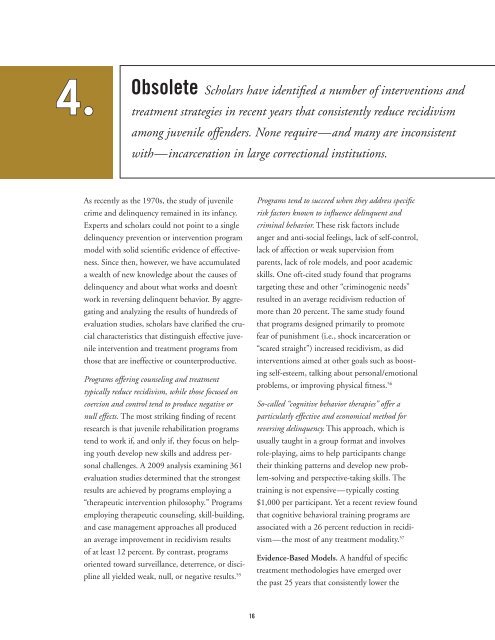aecf-NoPlaceForKidsFullReport-2011
aecf-NoPlaceForKidsFullReport-2011
aecf-NoPlaceForKidsFullReport-2011
Create successful ePaper yourself
Turn your PDF publications into a flip-book with our unique Google optimized e-Paper software.
4.Obsolete Scholars have identified a number of interventions andtreatment strategies in recent years that consistently reduce recidivismamong juvenile offenders. None require—and many are inconsistentwith—incarceration in large correctional institutions.As recently as the 1970s, the study of juvenilecrime and delinquency remained in its infancy.Experts and scholars could not point to a singledelinquency prevention or intervention programmodel with solid scientific evidence of effectiveness.Since then, however, we have accumulateda wealth of new knowledge about the causes ofdelinquency and about what works and doesn’twork in reversing delinquent behavior. By aggregatingand analyzing the results of hundreds ofevaluation studies, scholars have clarified the crucialcharacteristics that distinguish effective juvenileintervention and treatment programs fromthose that are ineffective or counterproductive.Programs offering counseling and treatmenttypically reduce recidivism, while those focused oncoercion and control tend to produce negative ornull effects. The most striking finding of recentresearch is that juvenile rehabilitation programstend to work if, and only if, they focus on helpingyouth develop new skills and address personalchallenges. A 2009 analysis examining 361evaluation studies determined that the strongestresults are achieved by programs employing a“therapeutic intervention philosophy.” Programsemploying therapeutic counseling, skill-building,and case management approaches all producedan average improvement in recidivism resultsof at least 12 percent. By contrast, programsoriented toward surveillance, deterrence, or disciplineall yielded weak, null, or negative results. 55Programs tend to succeed when they address specificrisk factors known to influence delinquent andcriminal behavior. These risk factors includeanger and anti-social feelings, lack of self-control,lack of affection or weak supervision fromparents, lack of role models, and poor academicskills. One oft-cited study found that programstargeting these and other “criminogenic needs”resulted in an average recidivism reduction ofmore than 20 percent. The same study foundthat programs designed primarily to promotefear of punishment (i.e., shock incarceration or“scared straight”) increased recidivism, as didinterventions aimed at other goals such as boostingself-esteem, talking about personal/emotionalproblems, or improving physical fitness. 56So-called “cognitive behavior therapies” offer aparticularly effective and economical method forreversing delinquency. This approach, which isusually taught in a group format and involvesrole-playing, aims to help participants changetheir thinking patterns and develop new problem-solvingand perspective-taking skills. Thetraining is not expensive—typically costing$1,000 per participant. Yet a recent review foundthat cognitive behavioral training programs areassociated with a 26 percent reduction in recidivism—themost of any treatment modality. 57Evidence-Based Models. A handful of specifictreatment methodologies have emerged overthe past 25 years that consistently lower the16



